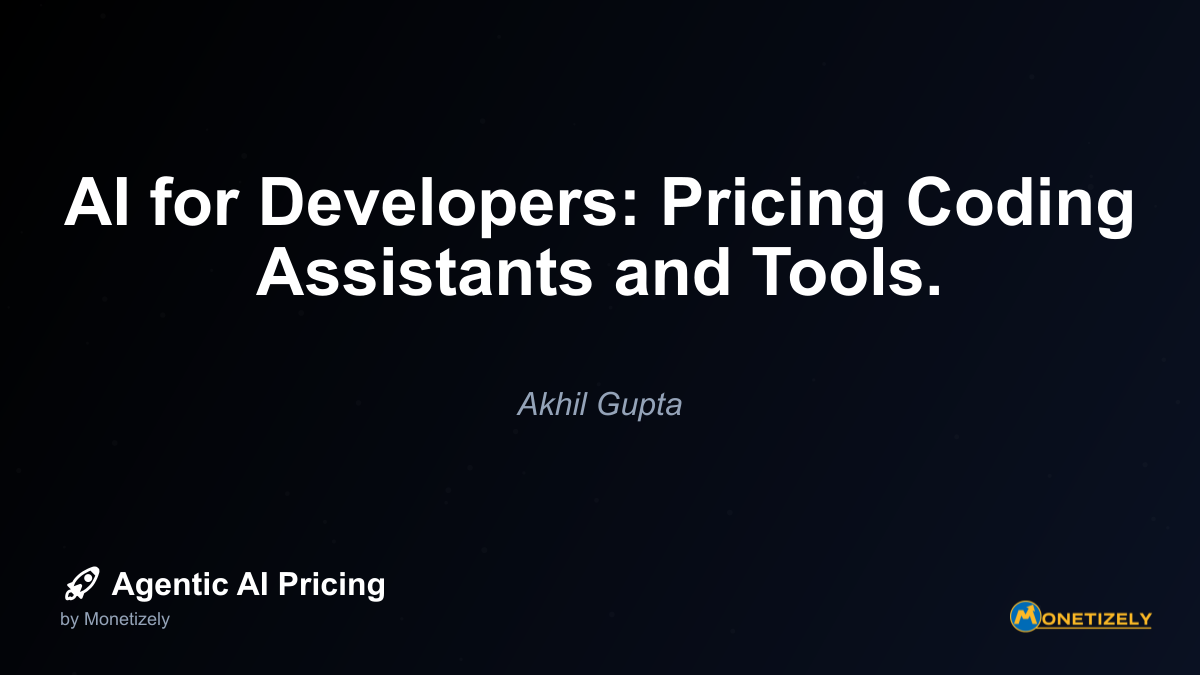· Akhil Gupta · Industry Insights · 5 min read
AI for Developers: Pricing Coding Assistants and Tools.
AI and SaaS Pricing Masterclass
Learn the art of strategic pricing directly from industry experts. Our comprehensive course provides frameworks and methodologies for optimizing your pricing strategy in the evolving AI landscape. Earn a professional certification that can be imported directly to your LinkedIn profile.

Developer Training and Best Practices
To maximize the effectiveness of AI coding assistants, organizations should:
- Provide structured training on how to effectively prompt and interact with the AI
- Establish guidelines for when to accept, modify, or reject AI suggestions
- Create repositories of organization-specific prompts that align with internal coding standards
- Encourage critical review of all generated code
Measuring Beyond Simple Metrics
While time savings are the most obvious benefit, organizations should track a broader set of metrics:
- Code quality metrics (complexity, maintainability)
- Developer satisfaction scores
- Onboarding time for new team members
- Consistency across different developers and teams
- Innovation metrics (new approaches discovered)
Challenges and Considerations in AI Coding Assistant Pricing
Despite their promise, AI coding tools present several challenges that organizations must address:
Licensing and IP Concerns
The training data used by AI assistants often includes open-source code with various licenses. This raises questions about the intellectual property status of generated code and potential licensing obligations. Organizations should:
- Review the terms of service for AI coding tools carefully
- Establish clear policies on when and how generated code can be used
- Consider the implications for proprietary software
Security and Compliance
AI assistants may inadvertently suggest code with security vulnerabilities or compliance issues. Organizations operating in regulated industries need to:
- Implement code review procedures specific to AI-generated content
- Consider the data privacy implications of code being sent to external AI services
- Evaluate whether certain sensitive components should be excluded from AI assistance
Skill Atrophy Concerns
Some organizations worry that overreliance on AI assistants could lead to skill atrophy among developers. To mitigate this risk:
- Encourage developers to understand the code being suggested
- Maintain educational initiatives focused on fundamentals
- Use AI as an accelerator rather than a replacement for core skills
Case Studies: Real-World ROI from AI Coding Tools
Enterprise Implementation
A Fortune 500 financial services company implemented GitHub Copilot across a development team of 200 engineers. Their findings after six months included:
- 23% reduction in time to complete standard feature implementations
- 18% fewer bugs discovered in code review
- $2.1 million estimated annual value from productivity improvements
- 92% of developers reporting they would find it difficult to return to coding without AI assistance
The company calculated an ROI of approximately 8.5x on their annual investment in the tool.
Startup Environment
A Series B startup with 15 developers adopted an AI coding assistant and tracked these results:
- 30% faster onboarding for new developers
- Ability to maintain consistent code quality despite rapid team growth
- Estimated 15-20 hours saved per developer per month
- Critical capability for meeting aggressive product roadmap timelines with limited resources
For this organization, the qualitative benefits of maintaining velocity during growth proved even more valuable than the quantifiable time savings.
The Future of AI Coding Assistant Pricing
As the market matures, we can expect several evolutions in how these tools are priced and positioned:
Value-Based Pricing
More sophisticated pricing models that attempt to capture a portion of the actual value delivered are likely to emerge. These might include:
- Success-based components tied to measurable productivity improvements
- Different rates for different types of code generation (simple boilerplate vs. complex algorithms)
- Integration with project management systems to correlate AI assistance with project outcomes
Specialized Vertical Solutions
Rather than general-purpose coding assistants, we’ll likely see more specialized tools optimized for specific domains:
- Industry-specific assistants (healthcare, finance, etc.) with compliance awareness
- Framework-specific tools optimized for particular ecosystems
- Security-focused assistants that prioritize secure coding practices
These specialized tools may command premium pricing based on their targeted value.
Enterprise Integration and Customization
For larger organizations, the ability to customize AI assistants with company-specific code patterns, libraries, and standards will become increasingly important:
- Private models trained on internal codebases
- Integration with proprietary components and services
- Custom rules and guardrails specific to organizational requirements
Such customization will likely come with premium pricing tiers but deliver substantially higher value for organizations with unique requirements.
Making the Decision: Is an AI Coding Assistant Worth It?
For organizations evaluating whether to invest in AI coding assistants, consider this decision framework:
Start with a clear assessment of current development bottlenecks
- Where do developers spend most of their time?
- Which tasks are most repetitive or error-prone?
- What knowledge gaps exist between team members?
Conduct a time-limited pilot with clear metrics
- Select a representative group of developers
- Establish baseline productivity metrics
- Set specific goals for the pilot period
- Gather both quantitative and qualitative feedback
Calculate organization-specific ROI
- Factor in the fully loaded cost of development time
- Consider both immediate productivity gains and long-term benefits
- Include qualitative factors like developer satisfaction and retention
Develop a rollout and usage strategy
- Create guidelines for effective usage
- Establish review processes for AI-generated code
- Plan for ongoing evaluation and optimization
Conclusion
AI coding assistants represent a significant shift in how software is developed, offering compelling productivity benefits that typically justify their subscription costs for most organizations. However, realizing the full value of these tools requires thoughtful implementation, clear measurement, and ongoing optimization.
For development teams and their leadership, the question is no longer whether AI assistance provides value, but rather how to maximize that value while managing potential risks. Organizations that approach this technology strategically—with clear metrics, appropriate guardrails, and a focus on augmenting rather than replacing human expertise—stand to gain substantial competitive advantages.
As these tools continue to evolve, their pricing models will likely become more sophisticated, potentially aligning costs more directly with value delivered. Forward-thinking organizations should not only evaluate current offerings but also prepare for a future where AI assistance becomes an integral part of the development workflow.
The most successful implementations will be those that view AI coding assistants not merely as productivity tools but as strategic assets that can transform how organizations approach software development—reducing time-to-market, improving quality, and allowing developers to focus their talents on the highest-value aspects of creating software.
Co-Founder & COO
Akhil is an Engineering leader with over 16+ years of experience in building, managing and scaling web-scale, high throughput enterprise applications and teams. He has worked with and led technology teams at FabAlley, BuildSupply and Healthians. He is a graduate from Delhi College of Engineering and UC Berkeley certified CTO.
Pricing Strategy Audit
Let our experts analyze your current pricing strategy and identify opportunities for improvement. Our data-driven assessment will help you unlock untapped revenue potential and optimize your AI pricing approach.




